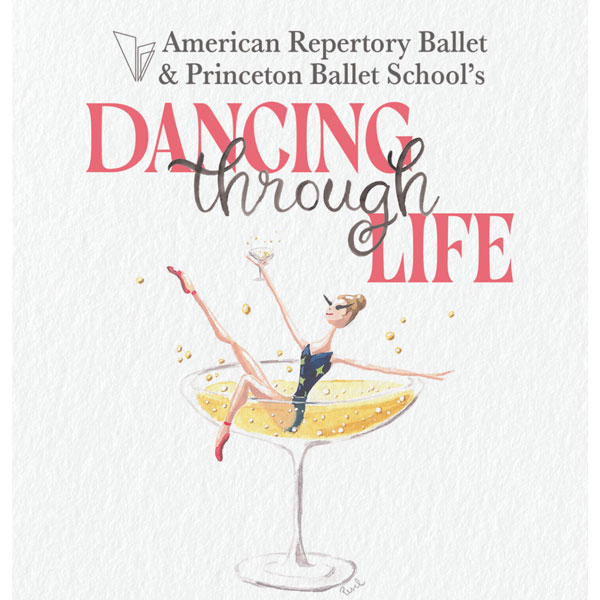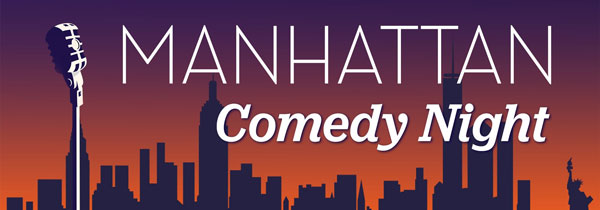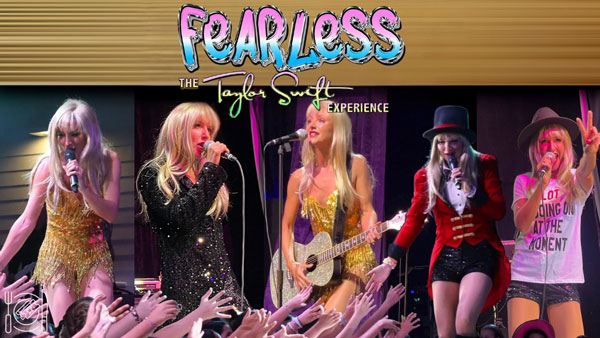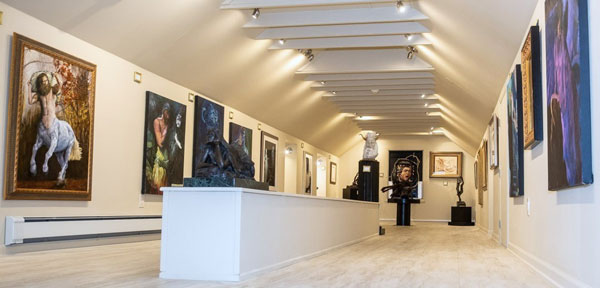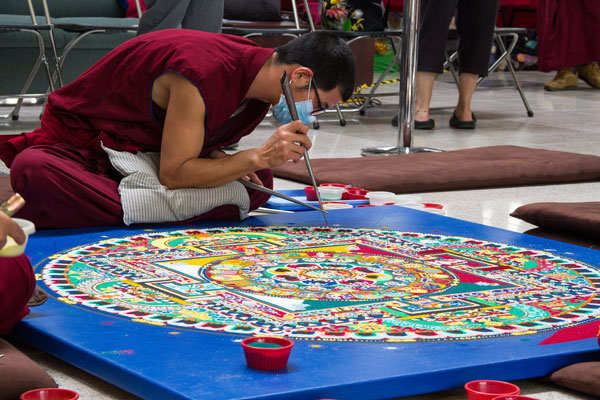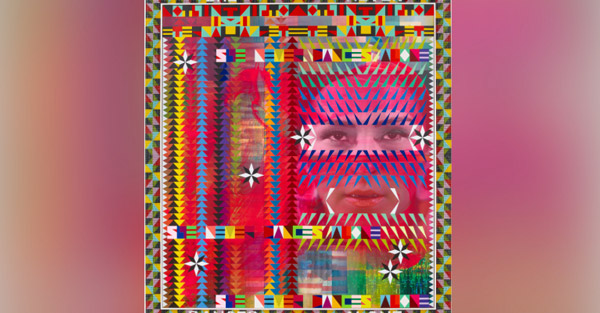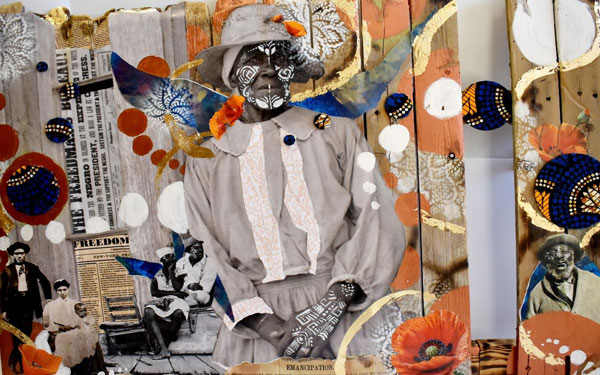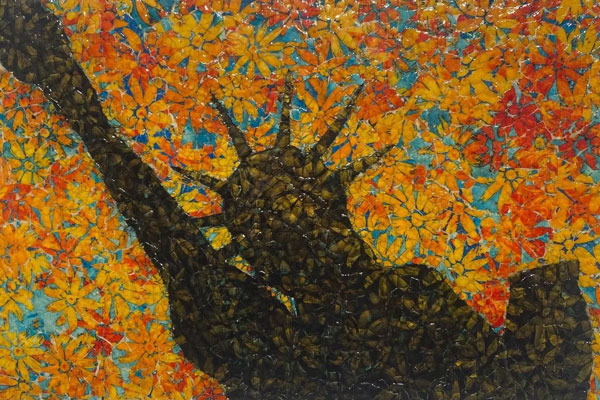By Sara Catherine Lichon
originally published: 06/26/2024
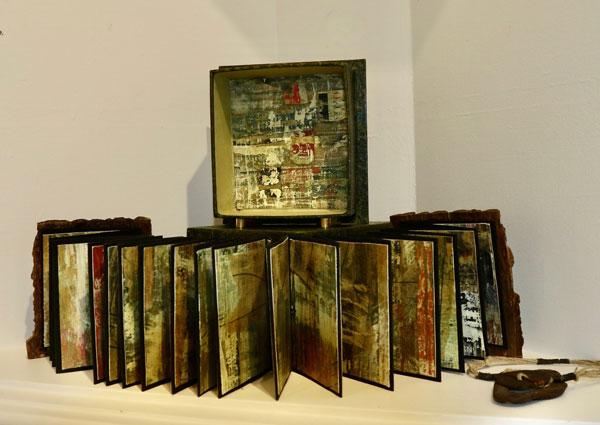
Liz Mitchell - Observations VIII. Photo by Carl Klemme
New Jersey has a truly diverse and thriving art scene, drawing inspiration everywhere from the high rises of Jersey City to the tree canopy in Hunterdon County. This is the theme of WhittemoreCCC (WCCC)'s latest art exhibit, "Bridging Nature." This exhibit not only comments on how humanity can connect to nature, but also creates a bridge between the two seemingly-distant sides of northern New Jersey: the eastern, more dense metropolises and the western, more rural forests and fields. With almost 40 submissions, WCCC's first small-works exhibit brings together a large array of ideas about nature, while also tying together several strands of the Jersey art scene into one stunning tapestry.
Spearheading this bridge’s construction is Tris McCall, well-renowned Jersey-focused art critic and musician. McCall has a long history of being immersed in the Jersey art scene, and he understands the importance of the Garden State’s green, open spaces. Because of his love for Jersey art, McCall sees how art can be the rope that pulls eastern Jersey and western Jersey together. With the assistance of Terri Fraser, artist and WCCC art consultant, McCall placed “Bridging Nature’s” artwork and selected Best in Show – Liz Mitchell’s “Observations VIII” – along with four other Honorable Mentions: Elena Stokes (“Horizon”), Michael McFadden (“Such a Square Am I”), Ken Ross (“Landscape”), and Katie Truk (“Revolving Door”).
A true small-works exhibit, every piece is 12” x 12” or smaller. When it comes to the show’s theme, Terri explains that artists were given maximum creative liberty. “It is open enough that, however an artist interprets what it means, it gives them the freedom and the flexibility to do that. Nature could be Mother Nature, Human Nature, however you see that. And because this is WCCC, and WCCC is all about Mother Nature, hopefully people were thinking, ‘How do I bridge Human Nature and Mother Nature together? Maybe I’m going to bridge my way of seeing so that it also goes into nature-form.’”

Terri Fraser, Tris McCall & Carolyn Thow. Photo by Carl Klemme
All of the pieces do just that, inviting gallery-goers into the natural world through a variety of mediums, from sculpture to wirework to needlework to painting to photography. “I was looking at line of sight, what it would look like when you first walk into the room,” McCall explains. “I know I had two anchor pieces, one was Katie Truk’s piece (“Revolving Door”), and I knew I wanted that to be the anchor of the first room. And I wanted Valeria Huhn’s piece (“The Knight of Mirrors”) to be the anchor of the other one. So, then it became, if I’m going to stand here, then what do I see? If I’m standing behind this piece, what am I going to see? And how’s this going to affect the way I look at other stuff?”
Each art piece plays off each other, and it’s easy to find a coherent flow as you move around the room. “I felt like all the pieces started talking to each other, almost immediately,” says McCall. And it’s true; the 3D sculptures – such as Huhn’s tree with colorful mirrors and plexiglass, Fraser’s spikey wire structure housing a soft heart of wool, and Bonnie Berkowitz’s beaded book – invite you to move around them to inspect each angle. From each viewpoint, if you look up, your eyes are drawn to many square canvases along the wall: some photographs or paintings depicting dramatic animals that stare into your soul. Others, colorful collages of painted patterns and shapes, such as McFadden’s watercolor mosaic, or Honore Young’s 3D flowers escaping from a picture frame. Every piece incorporates nature in some way, whether it’s obvious or abstract.
Truk’s “Revolving Door” and McFadden’s “Such a Square Am I” are two of the more abstract pieces, yet they are laced with conversation around both Human Nature and Mother Nature. Truk’s piece, a cube consisting of different color pantyhose stretched and twisted into different shapes, seems like a Picasso painting brought to life. “I feel like everything’s cyclical. How that door just revolves, and sometimes you can go in, sometimes you can come out,” Truk explains. “I feel like that’s our routine in life, with the seasons and everything like that. And the possibilities of that door as it opens!”
As you move around Truk’s piece, the shapes and colors change, creating a new work of art depending on the angle. “When I make pieces, I try to make them truly 3-dimensional so that, no matter how you hang it on the wall, no matter how you look at it, the picture will change.” At first glance, you may wonder what her piece has to do with nature. But it’s the medium of choice that hits her point home – pantyhose are, by nature, impermanent. The more they are worn, the more they wear away, and eventually they will disappear entirely. Appreciating Truk’s artwork is a reminder that we need to appreciate nature while we still have it. “Environment is so important, that I’m hoping that we take moments of time to appreciate it, how it’s necessary,” Truk says. “Be expressive, take a breath, take a look around, it might not be here, so pay attention.”

Katie Truk - Revolving Door. Photo by Carl Klemme
McFadden, meanwhile, refers to his piece as an improvisation. While he has several works that would have qualified for this exhibit, “Such a Square Am I” is the one that stuck. “For years I’ve been doing improvisations in sketchbooks. Once in a while, if you work a lot, sometimes something just happens. And it feels magical. It just captivated me. I knew exactly what to do next. And I knew exactly when it was finished.”
“Such a Square Am I” has many layers to it, different lines of color layered one on top of another, creating a vibrant and whimsical display. But if you look closer, there are specific images within each color. “Each layer is a separate painting,” McFadden remarks. “If you were to go back and look at each painting, you would see that each color is a different image. Some of them are abstract, some of them are figurative.” The colors chosen invoke images of tree branches, rocks, and water, all of which are bridged together by McFadden’s brush strokes. “It’s ironic that the theme is ‘Bridging Nature,’ because when I do these improvisations, they’re often landscapes,” says McFadden. “And another thing I find comes into my work a lot is bridges. It’s a shape that translates to that.”
In-between abstract and direct lies Stokes’s “Horizon.” At first glance, her woven colorful strands appear to be simply calming and abstract colors, but upon closer inspection, you realize they stitch together a gentle sunset. Trained as a quilter who wanted to develop her own unique style, Stokes weaved together recycled saree silks, through a meditative process of unwinding, ironing, cutting, and weaving. “The fact that they’re sort of blocks of color, when I do the design work, it ends up being very abstract art because it’s so blocky,” Stokes says. There are three layers on her small canvas: backing fabric, middle butting, and a top collage and stitched design. The frayed edges of the canvas represent infinity, as Stokes imagines the landscape continues off the canvas and into our world.

Elena Stokes, photo by Carl Klemme
Stokes hopes her work will remind people to connect with nature and ground themselves. “Everybody loves nature. In this crazy, mixed-up world, this is where we literally ground ourselves. A lot of quilt artists want to bring a lot of the issues that we see on the media and put it on their work. Well, no, that’s not me. I want to take everyone away from that. That’s what nature’s all about. That’s what I want to bring to people, I want to bring some source of peace.”
Ross’s “Landscape,” meanwhile, immediately creates a bridge between viewer and nature. A photograph through a raindrop-covered screen looking out into a field, “Landscape” evokes a yearning we’ve all felt, when we want to escape outdoors but the rain keeps us inside. “The piece is an artist printed ink jet print. The original exposure was captured digitally and represents a view through a screened window of a wooded hillside,” Ross says. “My initial inspiration came from the view itself bathed, in soft light. The camera lens allows views to be seen quite differently than human vision. Areas of a scene may be described in varying degrees of clarity depending on the settings chosen by the photographer and recorded as such. In the case of my picture, I chose to focus on the screen, which forced the landscape to be rendered as a group of ambiguous tones suggesting a hillside. The interplay of the screen to the soft-focus natural forms expresses my feelings regarding humanities current relationship to the natural world.”

Ken Ross - Landscape, photo by Carl Klemme
And then there’s the Best in Show: Mitchell’s “Observations VIII.” Stitched between bark covers, worn images unfurl through an accordion of pages around the base of two wooden boxes, one open and reflecting the same worn image on the pages. “I work in larger paper sculpture most of the time, and then I come back to the handheld objects,” Mitchell explains. “I search specifically for the right kind of bark, which has a flat girth to it, and I make the collage paper that’s on the inside.”
It's no surprise that Mitchell’s piece won Best in Show, as it brings together Human Nature and Mother Nature in every sense. “A lot of my work is based on nature and where nature touches humanity,” says Mitchell. And this piece does just that. Made out of pieces of nature, such as tree bark, and built to a real book’s scale, this piece symbolizes the holding of the book in one’s hands, their fingers literally grazing the bark of the tree. “It resonates with that core that people have that allows nature to come into our lives. The familiarity of tree bark…it’s a vibration, a resonance, of letting nature into our lives.”
Interwoven through all 40 pieces is a sense of devotion to our home state’s natural environment. “There’s a real similarity between the anxieties that they [Hunterdon County artists] feel out here, and what we feel in the Meadowlands, where we actually see the Meadowlands being ruined,” McCall says. “Bridging Nature’s” artists are “aware of the ways in which we, as human beings, have a very big footprint. We’re making it hard for the birds and the bees to exist. And the pain of that shows up in all this artwork. It’s not an instinctive beauty of nature; it’s filtered through what we know about what we as human beings might be doing to nature. You feel that conversation when you look at this work all together.”

Photo by Carl Klemme
Regardless of where in New Jersey you’re from, the impact we have on the environment is felt throughout the state, and there’s a need to protect the environment in all corners of our home. “Bridging Nature” doesn’t just bridge together Hunterdon County humans and nature – through McCall’s vision and placement, it bridges all New Jerseyans with nature, across the state, and creates a connection between east and west. And this inspires all of us Jersey folk to come together to protect our natural resources. “We’re Jersey, we roll with forests,” remarks McCall. “Out here is Jersey, Newark is Jersey, Jersey City is Jersey. We understand each other.”
“Bridging Nature” is on display at WhittemoreCCC now until June 30. All art is available for sale and proceeds to benefit Friends of Whittemore. You can visit the gallery either by making an appointment or by visiting during the hours listed at https://www.whittemoreccc.org/.
Read more by Sara Catherine Lichon at her blog,
Sincerely SC. In 2019, I started Sincerely SC as a personal blog, itching for a writing outlet in my post-college life. This project quickly evolved into a full-on freelance writing venture as I discovered my passion for hearing and sharing the stories of the world. Life is a journey, filled with many stories, just waiting to be told – and I love telling them!
FEATURED EVENTS
To narrow results by date range, categories,
or region of New Jersey
click here for our advanced search.








